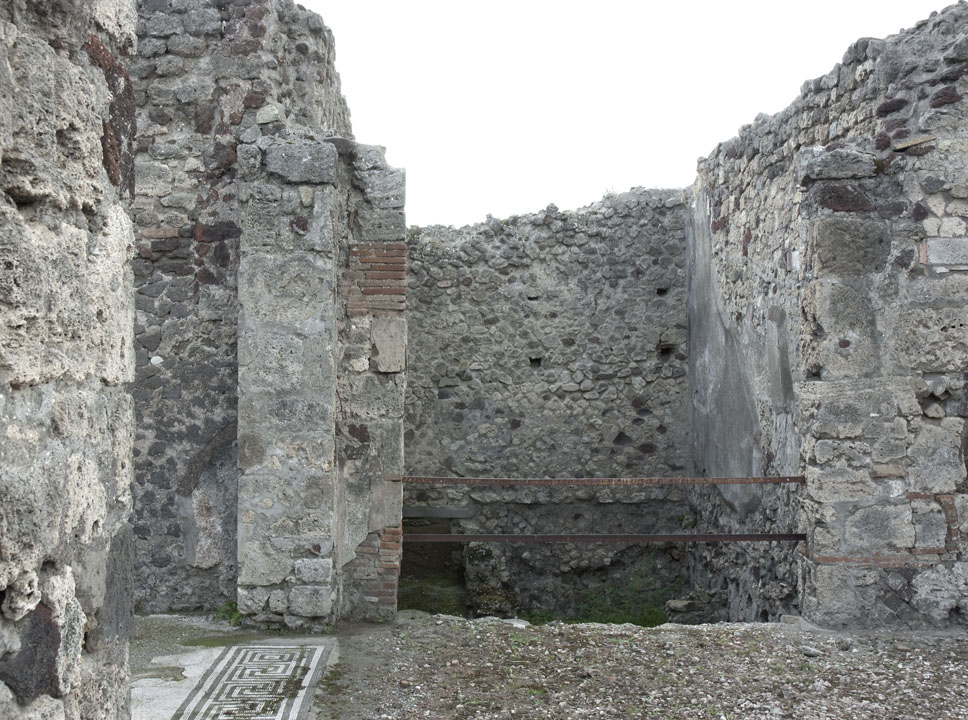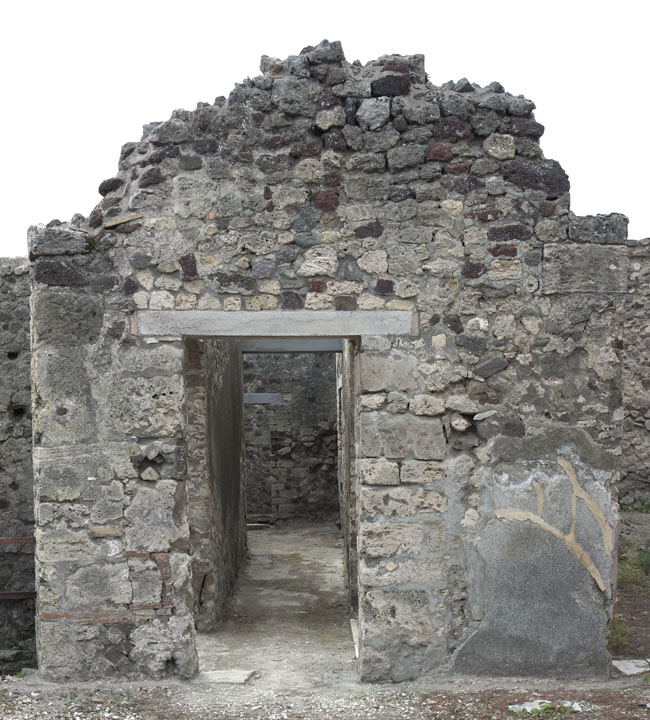West Wall
Description
Thomas Staub
W wall: width 12.45 m, max. preserved height 2.95 m (southern part) - 4.45 m (northern part).
The southernmost part of this wall, between the south-west corner and the opening towards room f, is 0.41 m wide and 2.80 m high. It is built, at the bottom, of one row of small ashlars of Sarno stone and cruma (0.06 - 0.10 x 0.08 m), there above 10 rows of bricks with modern concrete, then one 0.45 m high tuff block, of which the southern part is covered by plaster. The corner towards the opening is repaired with one piece of brick. Then at the door one standing Sarno stone block, 0.12 x 0.30 m, is at the corner filled with cruma rubble, set in to a yellowish mortar. Then follows one laying Sarno stone block, 0.41 x 0.25 m, then, at the opening towards room f, again a stander (0.20 x 0.35 m) of tuff, the inner corner filled with Sarno stone rubble in yellowish mortar, partly covered with under plaster. Above this, the part of the wall consists of three more Sarno stone blocks, 0.20 - 0.25 m high, partly with filling of cruma in the south corner, partly with modern repairs. Even the inner side of the southern doorframe towards room f is partly covered by plaster.
After the wide doorway towards room f (width 2.57 m) follows the next section of the wall, reaching till the door opening towards room g (width of the door to h1 1.15 m, height 2.20 m). This section is 3.70 m wide and 4.05 m high, but is set up in a modern reconstruction above a height of 1.60 m between the doors to room f and the corridor h1, incl. the area above this door. At the bottom, the wall is on both sides framed by standing Sarno stone blocks, 0.40 m high, the southern 0.20 m, the northern 0.40 m wide. The area in-between consists of opus quasireticulatum of small tuff and cruma blocks (0.10 x 0.10 m). Above this, the wall consists mainly of Sarno stone blocks of varying dimensions (0.10 x 0.15 - 0.60 x 0.30 m). The areas between these are filled up with different materials as bricks or small rectangular cruma and tuff blocks placed as a reticulatum. Above this (height 1.60 m), the wall has been reconstructed in modern times.
The zone between the doors towards corridor h1 and room g is in its northern part covered with plaster up to a height of 1.40 m. Here one can observe that the pavement in cocciopesto abuts against the plaster covering the wall. The northern doorframe towards corridor h1 is constructed of stretching Sarno stone blocks in a total width of 0.60 m, in the upper zone, under the modern lintel, also some blocks in tuff (dimensions of the blocks between 0.30 x 0.15 m and 0.60 x 0.30 m). To the north of these blocks, the wall is made of a mixed opus incertum containing Sarno stone, cruma, tuff and lava rubble and spolias of pavements and stones with the reddish mortar, set into a yellowish mortar. The front of the doorframe towards room g is constructed with small blocks in the same materials, partly covered with plaster containing shards of ceramics. Above 2.50 m height, the wall is reconstructed in modern times.
After the 2.75 m wide opening towards room g follows the 2.95 m wide northernmost section of the wall. Plaster covers the lower zone of the northern part up to 0.40 - 1.90 m of height. Near the north-west corner, above the entrance to the small barrel-vaulted cellar underneath the northern part of the west portico, one can observe that the plaster here abuts against the floor, i.e. contrary relations as observed in the central part of the west wall, noted above. The first part of this section, a 0.35 m wide zone next to the door, is destroyed, only some pieces of Sarno stone and lava remain at floor level. Then follows two standing ashlars of tuff, 0.30 x 0.60 m and 0.35 x 0.60 m, and then a 0.90 m wide section of the wall, 2.00 m high, that is nearly completely covered by plaster, only at the top the materials of the mixed opus incertum are visible. They consist of Sarno stone, lava, cruma and brick rubble, set into a greyish mortar. After this section, there is a clearly visible vertical line in the masonry, followed by a further area with mixed opus incertum, which is covered by plaster up to a height of 0.55 - 1.20 m and, in its higher parts, by modern concrete. The incertum consists of mainly rubble, with some pieces of ashlars of Sarno stone, lava, cruma, tuff and pieces of tiles, all set into a yellowish mortar. Only in its lowest parts, visible for ca. 0.05 - 0.10 m above the plastered area, the incertum seems to consist of lava, set into the reddish mortar. In 3.60 m height, 0.40 m from the north-west corner, a 0.10 x 0.10 m large hole is visible in the wall, probably from a missing stone.



